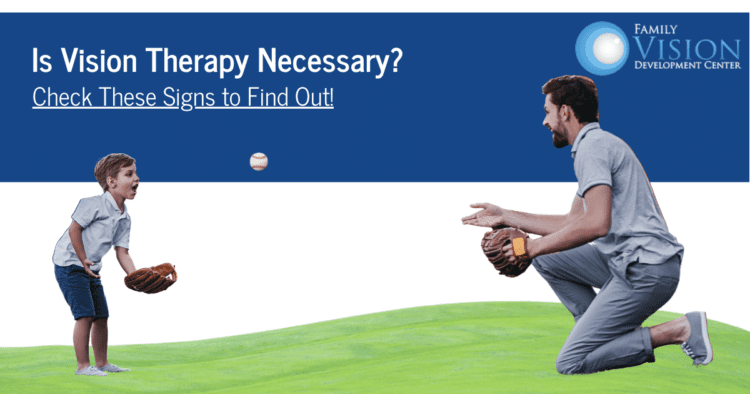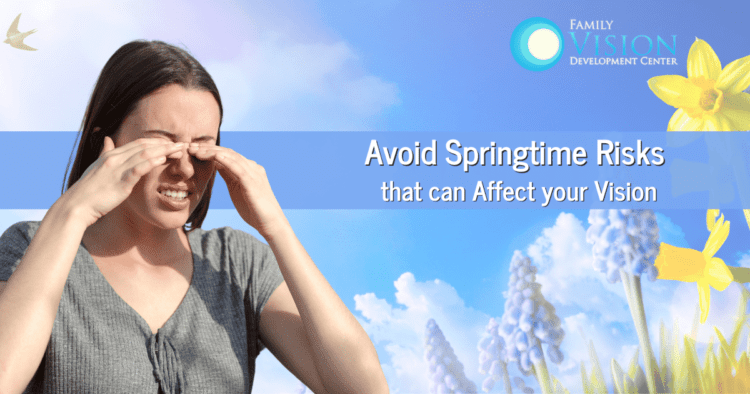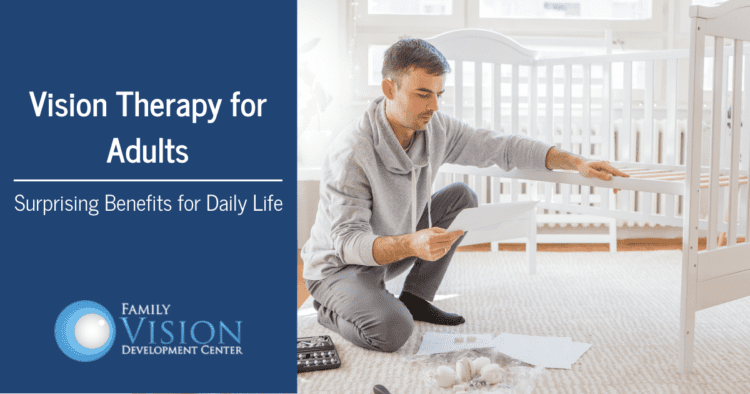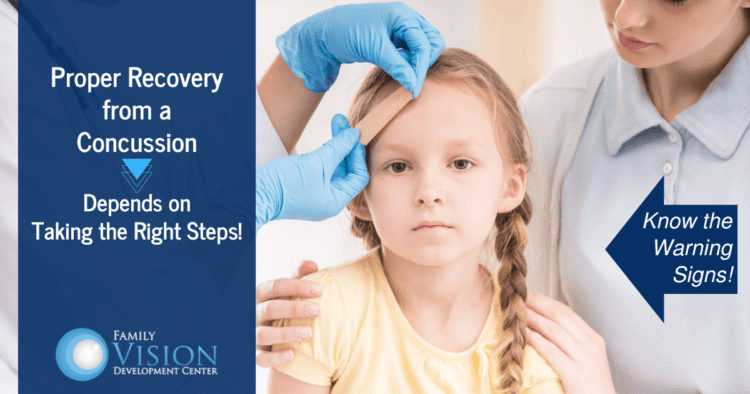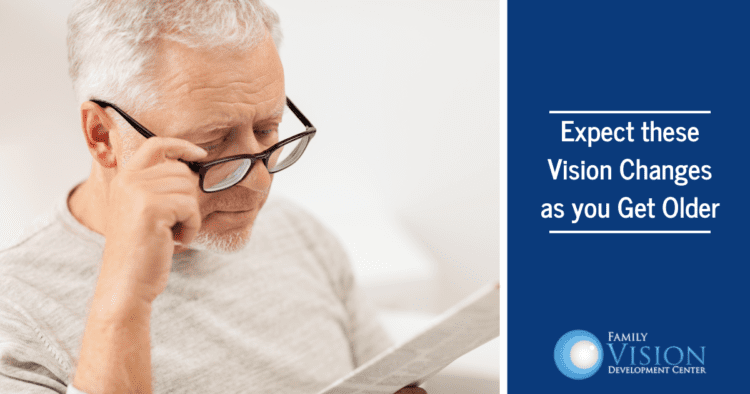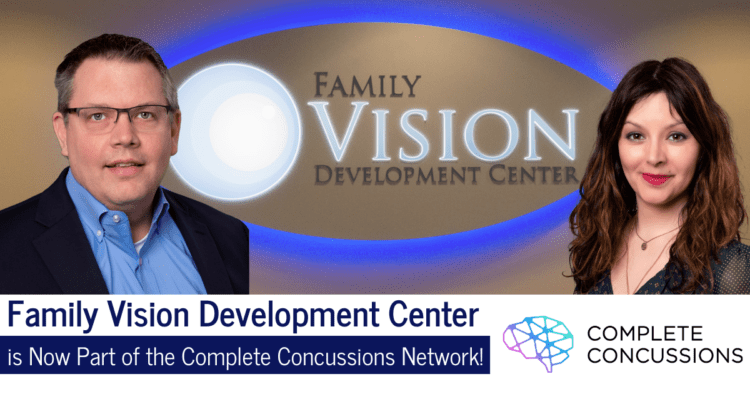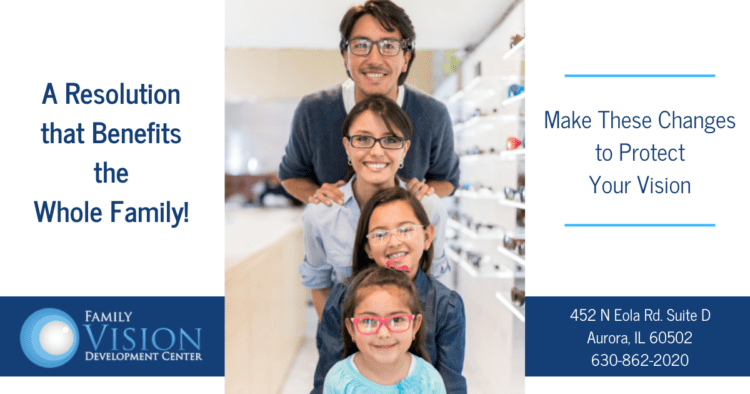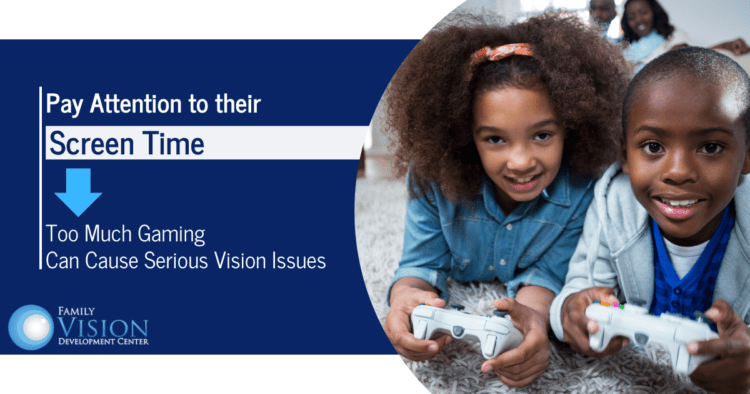Vision therapy is a type of eye therapy that helps to improve eye coordination, focusing, and eye movement. It is used to treat a variety of vision problems, including:
- Amblyopia (lazy eye)
- Strabismus (crossed eyes)
- Convergence insufficiency
- Accommodative insufficiency
- Diplopia (double vision)
Why Explore Vision Therapy
Vision therapy can be an extremely effective way to treat a variety of vision disorders that can affect your child’s performance in school, participation in sports and overall confidence and quality of life. The individual sessions are customized to treat your child’s specific visual concerns and can be much more successful than glasses alone.
The team at Family Vision Development Center is highly trained in advanced vision therapy services. Our individualized treatment sessions are performed right in our office and can include a variety of eye exercises, activities or games that kids can easily adapt to.
While vision therapy is a great option for correcting your child’s vision, it is not always easy for a child to recognize what the problem is. Kids are sometimes not even aware that a vision issue is present, or they are not able to express the difficulty they are having. As a parent or caregiver, there are some signs to watch for that can indicate an underlying vision condition that could be treated with vision therapy.
10 Signs of a Possible Vision Condition
- Difficulty keeping their eyes focused. One sign of a focusing issue is when a child cannot maintain clarity when looking from something up close to something far away. They may complain of motion sickness, fatigue or blurry vision. Additionally, kids that sit in the back of the classroom can have difficulty with work being done at the front of the room.
- Difficulty tracking moving objects. You may notice signs of an eye tracking problem when your child is playing catch. If they have difficulty following a moving ball, and frequently miss what seems to be an easy catch, this can be a big indicator of a vision problem.
- Double vision. A child may not be able to communicate that they are seeing two of the same object. However, you can look for the telltale signs, such as squinting, covering one eye or frequently rubbing their eyes.
- Frequent headaches. Headaches can be a sign of a variety of vision problems, including amblyopia, strabismus, and convergence insufficiency. When a child is experiencing blurry vision, double vision, digital eye strain or other vision issues, a common symptom is a headache.
- Reading issues. Many vision problems can impact a child’s ability to read. For instance, you may notice that your child frequently loses their place, skips words, re-reads words or confuses similar words. Additionally, they might have poor overall reading comprehension or a reduced attention span.
- Writing is difficult. Similar to reading problems, vision issues can also make writing difficult for kids. You may notice your child’s writing is messy, they make mistakes, or they have difficulty staying on the line. They may also write words, numbers or letters in reverse. Any of these signs should be a reason to test their vision.
- Issues with paying attention in school. Children with attention issues are often labeled with ADHD without additional testing. However, if your child is easily distracted, has difficulty following directions, or does not complete their work, they could actually be suffering from an undiagnosed vision condition.
- Poor participation in sports. Athletic ability can be very dependent on proper visual skills. For instance, if your child has difficulty catching or throwing a ball, or they have trouble tracking the ball, the reason could be a vision condition.
- Difficulty driving. Young drivers may not be completely confident behind the wheel. However, there are some signs that could indicate a vision issue, rather than a lack of experience. For instance, if they have difficulty staying in their lane, judging distances, or seeing at night, you should have their vision checked.
- Depth perception issues. This can be a difficult problem for a child to explain. But you can watch for signs of a depth perception issue that include difficulty judging distances, bumping into things, frequently tripping or falling, or difficulty catching or throwing a ball.
Vision Therapy at Family Vision Development Center
If you notice any of these signs in your child, it is important to schedule an appointment for a comprehensive vision exam so we can properly diagnose the issue and determine if vision therapy is the best form of treatment. Take the first step by contacting our Aurora office at 630-862-2020 to schedule your appointment today.
Family Vision Development Center is a full-service vision center offering innovative vision therapy services, post-concussive vision rehabilitation, comprehensive vision exams for eyeglasses and contact lenses, management of ocular diseases including glaucoma, diabetes, macular degeneration and cataracts, and a state-of-the-art optical center offering the latest designs in eyewear.
As the days get longer and the weather gets warmer, it’s time to start thinking about proper eye care for spring. Taking care of your eyes is important all year round, but it’s especially crucial during the spring season when allergies are at their peak and the sun’s rays are getting stronger. The following tips will help you keep your eyes and vision protected as you get out to enjoy the spring days.
Purchase Quality Sunglasses
While you should be protecting your eyes year-round from the sun’s harmful rays, this time of year can be the worst time for exposure. Many people begin to spend more time outdoors when spring arrives and they may not remember the importance of keeping their eyes sheltered from the sun. Quality sunglasses do not have to be expensive, but they do need to block 100% of harmful UV rays. You should look for the largest lenses possible to protect your eyes from sun damage. Additionally, polarized lenses can help to protect against glare that bounces off reflective surfaces like roads or water.
Prepare for Spring Allergies
Allergies are a major source of discomfort this time of year, and they can definitely be hard on your eyes. Pollens, dust mites, pet dander, and mold spores are all common sources of allergies this time of year, so it’s important to take steps to reduce your exposure to these irritants. Investing in a good air filter, avoiding outdoor activities when pollen levels are at their peak, and washing your hands and face after being outside can all help to reduce your allergy symptoms. Allergy medications can also be necessary in some cases in order to manage your symptoms and keep your eyes healthy.
Dry Eye Remedies
Dry eye symptoms tend to be most problematic in spring when pollen counts are high. These symptoms can include itchiness, redness, burning or stinging, soreness or blurry vision. Rubbing your eyes may be an instinctive reaction but that can cause further irritation. Some helpful remedies to combat dry eyes in the spring include using a humidifier indoors, drinking lots of fluids, or using prescription or non-prescription eye drops or artificial tears. Not only do these drops keep your eyes lubricated and comfortable, but they can also be a great way to rinse out irritants and allergens.
Clean Your Home
Spring cleaning not only gets your home in order, but it can also contribute to your overall eye health. Deep cleaning the places you spend most of your time in, such as your home and workspace, can help eliminate pollens and other allergens. However, when cleaning, make sure to properly ventilate the area, as dust and irritants will likely get stirred up and may cause allergic reactions. Your spring cleaning routine is also a great time to wash bedspreads and curtains, as well as get rid of expired cosmetics that could lead to infections.
Again, while these are helpful suggestions to keep your eyes healthy in the spring, proper eye care should be on the top of your mind all year. Visiting Family Vision Development Center regularly for vision exams and other eye care services is the best way to maintain healthy vision for life. Schedule your appointment by calling our Aurora office at 630-862-2020.
Family Vision Development Center is a full-service vision center offering innovative vision therapy services, post-concussive vision rehabilitation, comprehensive vision exams for eyeglasses and contact lenses, management of ocular diseases including glaucoma, diabetes, macular degeneration and cataracts, and a state-of-the-art optical center offering the latest designs in eyewear. We are dedicated to keeping our patients comfortable and well-informed and we will explain every exam and procedure and answer all of your questions. We accept both scheduled and emergency appointments, and offer convenient financing and insurance options to ensure that high-quality vision care is available and affordable to all of our patients.
Vision therapy is often suggested as a treatment for children’s vision disorders. However, vision therapy for adults can be an incredibly effective option that should be explored for a variety of reasons. You may not realize it, but your eyesight is linked to your overall health and well-being. When you have poor vision, it can impact your ability to perform everyday tasks and may even lead to more serious health problems.
That’s where vision therapy comes in.
Vision therapy is a type of in-office rehabilitation that uses special eye exercises to treat a variety of vision problems. For example, it can be used to correct conditions such as lazy eye, crossed eyes, and even double vision. But vision therapy isn’t just for children – it can also be used to treat vision problems in adults.
There are many benefits of vision therapy that are often overlooked. Here are some surprising benefits of vision therapy for adults and how it can help improve your overall quality of life.
Better Depth Perception
Depth perception is the ability to accurately judge the distance and position of objects in space. It is a vital skill that is essential for everyday tasks such as driving, walking around, sports, and more. Poor depth perception can lead to issues with spatial awareness, coordination, and overall safety. Fortunately, vision therapy can help improve depth perception in adults. The individualized therapy programs can help to strengthen the eye muscles and help your eyes work together. The result is improved depth perception which can help you better perform everyday activities and improve your quality of life.
Improved Hand-Eye Coordination
Poor hand-eye coordination can lead to difficulty completing simple tasks, such as tying your shoes or writing something down. Hand-eye coordination is also important for playing sports, operating machinery, and other activities that require precise coordination. Fortunately, vision therapy can help improve hand-eye coordination in adults. The customized vision therapy exercises can help strengthen and improve the connection between your eyes and hands. This leads to a greater ability to complete these daily tasks that may have previously been difficult to accomplish.
Enhanced Fine Motor Skills
Fine motor skills are used for tasks such as handwriting, buttoning a shirt, or turning a key. As adults get older, they may find increasing difficulty completing these types of tasks. Vision therapy for adults can focus on developing these fine motor skills, thereby helping to improve and strengthen the muscles used for these types of activities.
Improved Reading Ability
Strong reading comprehension is necessary for success throughout life. In fact, activities such as understanding directions, applying for a job, giving a presentation or simply enjoying a good novel can be affected without proper reading skills. Many vision disorders that affect reading ability can be effectively treated through vision therapy for adults. For example, conditions such as convergence insufficiency (eye teaming), amblyopia (lazy eye), and strabismus (eye turn) can all be corrected through vision therapy for adults.
Greater Confidence
An adult that suffers from a vision disorder can feel self-conscious, embarrassed or socially withdrawn. Correcting visual impairments later in life can actually give an adult a renewed sense of confidence, as it improves their ability to accomplish tasks and interact with others. Additionally, overcoming the challenge of poor visual skills can provide the motivation and determination to persevere through life’s obstacles as they come up.
Contact Family Vision Development Center for Vision Therapy for Adults
At Family Vision Development Center, we specialize in individualized vision therapy programs for both children and adults. Contact us at 630-862-2020 to learn more about all the benefits of correcting your vision at any age.
Family Vision Development Center is a full-service vision center offering innovative vision therapy services, post-concussive vision rehabilitation, comprehensive vision exams for eyeglasses and contact lenses, management of ocular diseases including glaucoma, diabetes, macular degeneration and cataracts, and a state-of-the-art optical center offering the latest designs in eyewear.
A concussion is a type of traumatic brain injury (TBI) that occurs when a violent jolt or blow to the head causes the head and brain to move back and forth very quickly. Proper care following a concussion is essential in order to minimize the effects and prevent lasting repercussions. So, remember the following tips if you have been recently diagnosed or if you even suspect a concussion.
Concussion Do’s and Don’ts
DO immediately stop participating in physical activity. It is very important to get as much rest as possible for the first 24-48 hours. That means taking it easy and getting plenty of sleep, assuming you have not noticed any red flags that could indicate a more serious injury. These signs of a serious injury, such as a bleed or skull fracture, can include:
- Loss of consciousness
- Seizures or convulsions
- Weakness or numbness in arms or legs
- Unable to wake up easily
- Worsening headache
- Increasing confusion, slurred speech or odd behavior
- Bruising around the eyes or ears
- Amnesia
If you notice any of the above signs, seek emergency medical attention right away.
DON’T drive for the first 24 hours following a head injury. This time should be used for evaluation and rest. Similarly, you should avoid school or work until you feel better.
DO see your doctor for an evaluation as quickly as possible. It is always best to have a medical professional assess your injury and determine how serious it is.
DON’T ignore the symptoms. Unfortunately, concussion symptoms are not always easily recognizable. Therefore, watch for any of the following signs and symptoms, which can be cause for concern following a head injury:
- Headache
- Neck pain
- Light sensitivity
- Any changes in vision
- Nausea
- Vomiting
- Balance issues
- Memory loss
- Confusion or difficulty concentrating
- Feeling like you’re “in a fog”
- Anxiety, nervousness or depression
- More emotional or sad feelings
- Loss of energy
- Fatigue
- Sleeping too much or too little
DO understand that symptoms can appear right away, or you might not notice them for days, months or longer.
DON’T take pain relievers such as Advil, Motrin, Tylenol or Aleve, unless directed by your doctor. These can mask symptoms, making it difficult to fully understand the effects of the concussion.
DO follow all instructions provided by any healthcare professionals you are seeing. Even if you start to feel better, it is important to keep up with care protocols established by your doctors in order to maintain proper recovery.
DO seek treatment from a provider who is qualified to treat vision problems following a concussion. Our optometrists have advanced training in neuro-optometric vision rehabilitation. That means we specialize in brain injury-related problems and we know how to correctly diagnose and treat vision issues associated with this type of injury.
Visual Rehabilitation Following a Concussion
Vision problems following a concussion are extremely common and can become persistent if not treated properly. As such, Family Vision Development Center should be an integral part of your concussion recovery process. Our specialized neuro-optometric vision rehabilitation can help restore visual function that has been compromised following a concussion. For instance, this type of therapy is an effective treatment for issues with eye focusing, proper eye movements & tracking, depth perception, loss of peripheral vision and more, all of which can occur due to a concussion.
Early treatment is always best, so DO contact our office at 630-862-2020 for a neuro-optometric evaluation if you have been recently diagnosed with a concussion.
Family Vision Development Center is a full-service vision center offering innovative vision therapy services, post-concussive vision rehabilitation, comprehensive vision exams for eyeglasses and contact lenses, management of ocular diseases including glaucoma, diabetes, macular degeneration and cataracts, and a state-of-the-art optical center offering the latest designs in eyewear.
Some things just get better with age – like wine, cheese or even a lasting friendship! But we can’t always say the same for our vision. Unfortunately, aging can bring about a number of visual concerns. Some can be serious, but others, like those below, are often simply an effect of getting older. On the bright side, while you may not be able to completely avoid these common issues, there are ways to help minimize the effects.
Vision Issues that Tend to Worsen with Age
- Presbyopia – this is the gradual loss of the eyes’ ability to focus on close objects or small print. Indeed, it tends to be one of the most common complaints of getting older, as reading becomes much more difficult and headaches become more common as a result. For mild cases of presbyopia, simply holding things farther away when reading or increasing the font size on your screen can do the trick. However, as it progresses, glasses or contacts in the appropriate prescription may be needed for comfortable vision.
- Dry eyes – this occurs when there are not enough tears, or insufficient quality of tears, lubricating the eyes. This condition is very common in older adults. In fact, the majority of people over age 65 experience some level of dry eyes. However, lubricating tears are important to keep the surface of the eyes smooth, clear and comfortable, as well as wash away any foreign matter or debris. Eye drops or artificial tear solutions can help combat symptoms. Better yet, to prevent a bad case of dry eyes, you can stay hydrated, use a humidifier at home and wear sunglasses
- Cataracts – cataracts are a clouding of the eye lens that causes changes in vision. For example, you may experience blurry or cloudy vision, double vision, light sensitivity or you may see halos around lights. Unfortunately, the biggest risk factor for developing cataracts is age, so you can’t avoid that. However, protecting your eyes with sunglasses or brimmed hats, quitting smoking and eating a nutrient-rich diet of fruits and vegetables can help to combat other known risk factors. And if they become too bothersome, they can be easily removed through a common surgery.
Eye Care at Every Age
No matter your age, an annual vision exam is essential in order to maintain proper eye health. Many eye diseases start without any symptoms and therefore go unnoticed for long periods of time, making treatment options more difficult in some cases. A comprehensive eye exam is the best way to detect these diseases in their early stages when treatment is most effective for preventing vision loss. Additionally, regular visits help us to quickly identify unusual vision changes, as well as provide guidance throughout the years to keep your vision strong for your lifetime.
It’s never too late to start taking proper care of your vision! The caring team at Family Vision Development Center is dedicated to providing the best vision care to all of our patients, at every age. Be sure to contact our Aurora location at 630-862-2020 to schedule an appointment today.
Family Vision Development Center is a full-service vision center offering innovative vision therapy services, post-concussive vision rehabilitation, comprehensive vision exams for eyeglasses and contact lenses, management of ocular diseases including glaucoma, diabetes, macular degeneration and cataracts, and a state-of-the-art optical center offering the latest designs in eyewear. We are dedicated to keeping our patients comfortable and well-informed and we will explain every exam and procedure and answer all of your questions. We accept both scheduled and emergency appointments, and offer convenient financing and insurance options to ensure that high-quality vision care is available and affordable to all of our patients.
Family Vision Development Center is excited to announce our new affiliation with Complete Concussions! Through this new relationship we are confident you will receive the most comprehensive concussion care, by coordinating important instructions and information amongst your providers.
Complete Concussions Overview
Coordinating concussion care can be difficult. But it is important for all of your concussion providers to be aware of other care you may be receiving. Indeed, this is the most effective way to ensure proper treatment and recovery. Complete Concussions is a global network of concussion care providers with one centralized location for patient referrals, care instructions, follow-up protocols and more. Their primary focus is concussion care and management using a network of specialists, clinics and providers worldwide. This network allows your concussion care to be coordinated among providers, coaches, etc. by gathering all important information in one place.
Family Vision Development Center as a Partner
Family Vision Development Center is proud to be included in the selection of trusted providers in the Complete Concussions network. Our concussion care professionals are trained in advanced neuro-optometric vision rehabilitation treatments that are often necessary following a concussion. Our inclusion in this network will allow primary care physicians, physical therapists, parents and others who may not know where to turn for these specialized services, to easily locate and contact our office. Additionally, they will be able to access progress updates, request more information, and coordinate long-term solutions.
Coordinating your Vision Therapy Following a Concussion
A concussion can cause changes to your vision. When this happens, it is known as post-concussive vision syndrome. A person who experiences a blow to the head that results in a concussion could experience problems such as:
- Eye focusing – not being able to quickly and easily see an object clearly (objects look blurry)
- Eye Movements and Tracking – not able to easily follow a moving object from one spot to another, or switch fixation from one object to another. Sometimes this can be reported by students saying that words are moving on the page.
- Depth Perception Issues – difficulty with accurately judging the distance between objects.
- Eye Teaming – not able to get both eyes to work together to focus on an object, often reported as double vision
- Peripheral Vision Loss – problems with your wide-angle field of vision, or feeling like you’re looking through a narrow tube
- Fatigue – more intense than normal, and not alleviated by rest
- Headaches – headache pain is common following a head injury and can range from dull to pounding or throbbing
- Memory – long-term or short-term memory loss can occur immediately following a concussion or can develop weeks, months or years after
Vision therapy is an extremely effective form of treatment for post-concussive vision syndrome that occurs following a head injury. This type of individualized neuro-optometric vision rehabilitation helps to retrain the visual system to restore proper communication between the eyes and brain. Any of the above visual issues can affect athletic or school performance, and precautions should be taken to ensure the safety and well-being of an affected student. Coordinated concussion care can alert parents, coaches and doctors when it is safe for an athlete to return to play or a student to return to normal classroom activities.
To learn more about our new partnership, get more information about concussion care or to schedule an appointment, contact us at 630-862-2020.
Family Vision Development Center is a full-service vision center offering innovative vision therapy services, post-concussive vision rehabilitation, comprehensive vision exams for eyeglasses and contact lenses, management of ocular diseases including glaucoma, diabetes, macular degeneration and cataracts, and a state-of-the-art optical center offering the latest designs in eyewear. We are dedicated to keeping our patients comfortable and well-informed and we will explain every exam and procedure and answer all of your questions. We accept both scheduled and emergency appointments, and offer convenient financing and insurance options to ensure that high-quality vision care is available and affordable to all of our patients.
Parents with a struggling student may be quick to assume a learning issue is the cause. However, a vision condition that causes difficulty with eye tracking may actually be what is behind the problems. Understanding what eye tracking means, the importance of this visual function, and how to correct this type of disorder can help parents stay on top of their child’s visual health as well as their success in school.
Why Proper Eye Tracking is Important
Eye tracking, also called visual tracking, is the eyes’ ability to work in sync with each other to accurately follow moving objects. Additionally, this visual skill allows for precise movements from word to word in a line of text.
Eye tracking movements are an essential part of healthy vision and are important in everyday life. For example, some activities that require proper eye tracking skills include:
- Quick scanning for information (while reading or in the world around you)
- Following or catching a ball while playing sports
- Focusing while jumping from one spot to another
- Reading a book
- Writing in a straight line
- Maintaining attention on a task
If a child’s eye tracking skills are not properly developed, it can negatively affect their reading fluency and comprehension, writing and spelling abilities, math skills, test scores and sports performance. Furthermore, this effect on overall academic and athletic performance not only affects their potential grades, but their overall self-confidence as well.
Common Signs of an Eye Tracking Problem
A child may not always realize that they are experiencing difficulty because of a vision problem. However, there are signs to watch out for that can indicate an eye tracking issue.
- Frequently skipping lines or words or losing their place when reading
- Poor comprehension when reading
- Confusing similar words
- Writing words, numbers or letters in reverse
- Reading below grade level
- Rubbing or squinting their eyes when reading
- Frequent drowsiness after reading for short periods
- Using a finger as a marker or aid while reading
- Reduced attention span when reading
- Eye strain or headaches when doing close-up work like reading or homework
- Complains that words seem to float or move around on the page
- Poor or illegible handwriting
- Difficulty playing sports
How to Correct an Eye Tracking Issue
If you notice any of the above signs or symptoms, the best precaution is to get a comprehensive vision exam to positively identify any vision issues. It should be noted that if a child gets results from a vision screening that indicate 20/20 vision, that does NOT necessarily mean that they have perfect vision. In fact, 20/20 vision simply means they are able to clearly see a specific letter on an eye chart at a distance of 20 feet. This standard screening is not able to accurately diagnose a vision disorder, such as an eye tracking problem.
It should also be noted that a child will not simply outgrow an eye tracking issue. In essence, in order to correct an eye tracking problem, you must take specific action. In our experience, the most effective form of treatment for an eye tracking problem is a customized vision therapy program. At Family Vision Development Center, our providers are highly-trained in advanced vision therapy techniques. These programs consist of specific eye exercises that strengthen the neural connection between the eyes and the brain in order to restore normal eye movements.
Contact us at 630-862-2020 to discover how vision therapy can provide an incredible solution to your child’s school struggles. We look forward to helping your child achieve healthy vision as well as reach their full academic potential!
Family Vision Development Center is a full-service vision center offering innovative vision therapy services, post-concussive vision rehabilitation, comprehensive vision exams for eyeglasses and contact lenses, management of ocular diseases including glaucoma, diabetes, macular degeneration and cataracts, and a state-of-the-art optical center offering the latest designs in eyewear.
As the start of a new year rolls around, many people look for ways to improve their life for the upcoming year. This can be accomplished in many ways, and is different for each person. But one thing everyone should be focused on is how to promote better vision. Our vision is precious, and maintaining healthy vision for life is an important goal. Luckily, there are some very easy changes you can make right away to get started on that journey.
Wear Sunglasses
One of the easiest and most significant changes you can make to your daily routine to promote better vision is to make sure you wear sunglasses. Every day. Without question. Many people really underestimate the importance of this simple action. But the fact is, the sun’s harmful UV rays can cause serious vision damage. Wearing sunglasses each time you leave the house can help protect against cataracts, macular degeneration and more. As a bonus, they do not have to be expensive glasses. In fact, as long as they indicate either “100% UV protection”, “protection against UVA and UVB” or “UV400”, they should be effective at blocking rays.
Add More Vegetables into your Diet
At this time of year, many people make a resolution to start eating more healthy foods. This is a great idea in general for better health. But it can also lead to better vision. Research has indicated that certain vegetables contain a number of vitamins and minerals that are known to promote better vision. For example, kale, spinach, sweet potatoes and carrots can be good sources of Vitamin C, Vitamin A, beta-carotene, antioxidants, lutein and zeaxanthin. These eye-healthy nutrients can be added in throughout your daily meals to help you build better vision for life.
Be Diligent with Contact Lens Care
After getting comfortable wearing contacts, it is easy to sometimes neglect your care routine. Unfortunately, this common mistake can lead to vision problems if it becomes a habit. The truth is, consistent care is essential to maintain healthy vision. In this respect, it is important to properly clean and store your contacts according to your doctor’s instructions. This means using appropriate cleaning solutions (not saliva or water), washing your hands before touching your contacts, and always keeping them stored in a clean case.
Take a Break from Digital Screens
It is so easy to become engrossed in digital screens. From computer screens at work to phones throughout the day, or television screens in the evening, it seems that our entire days are spent staring at screens. But too much of this can lead to digital eye strain, with symptoms like headaches, blurry vision, dry eyes, light sensitivity and more. For better vision, be sure to take frequent breaks from your screens. A good rule to stick to is to give your eyes a break every 20 minutes, by looking at least 20 feet into the distance for at least 20 seconds (think 20/20/20).
Commit to an Annual Vision Exam
Many people take the time to see their doctor annually for a routine physical to maintain their overall health. However, it is just as important to see your eye doctor for regular eye exams, as many vision conditions are only detectable through a comprehensive evaluation. Early detection can often give you a far better opportunity to fully correct an issue. Regular exams allow your eye doctor to detect any changes in vision right away, and begin treatment faster.
At Family Vision Development Center, we want to help you achieve better vision for life. We provide essential vision care services for patients of all ages, including vision exams, vision therapy services, post-concussive vision treatment, and a state-of-the-art optical center for eyeglasses and contact lenses. Contact us at 630-862-2020 to schedule your appointment today and make your vision a priority in the new year!
Winter months bring dropping temperatures and thoughts of holiday festivities. However, vision care may not be on the top of the list of concerns during this time. But unfortunately, cold weather can present some issues when it comes to your eyes and vision. Here are some tips to keep your eyes protected against winter dangers.
Wear sunglasses
Sun protection is not just a summer concern! Just because it’s winter doesn’t mean the sun’s UV rays can’t harm your eyes. In fact, glare from the sun can be particularly harsh in winter, and UV rays reflecting off surfaces including snow, pavement, metal and water can damage your eyes year-round. UV exposure is associated with an increased risk of cataracts and age-related macular degeneration. Therefore, it is essential to always wear proper sunglasses that block both UVA and UVB rays.
Wear other protective eyewear
Speaking of eye protection, sunglasses are not the only eyewear you might need during winter. Many people like to partake in fun winter sports like skiing or snowmobiling. However, these activities can present risks to your eyes if the proper precautions are not taken. Wearing protective goggles can shield eyes from UV rays and hazardous glare, as well as protect against flying snow and debris.
Keep your Eyes Moisturized
Winter months are notorious for dry indoor air. Prolonged exposure to this lack of humidity can cause your eyes to become irritated, itchy and sore. Additionally, dry air can cause a burning sensation or excessive watering. To combat this, try using a humidifier in your home to add moisture back into the air. Even better, applying artificial tears directly into your eyes can help to lubricate dry eyes and add moisture to the surface of the eye.
Seek Concussion Care Immediately
Unfortunately, winter months come with icy conditions. And that means there is an increased chance of slipping and falling. If you fall and hit your head, you need to take quick action to avoid any lasting effects of a concussion. Concussions can have a significant effect on vision. For example, you might experience blurred or double vision, difficulty focusing, dizziness, headaches, eye pain or light sensitivity. Or you may not even notice any symptoms at all for several days or more.
Even a mild concussion can cause serious vision problems over time, so seek care immediately even if you are not experiencing symptoms right away. We offer specialized care in neuro-optometric vision rehabilitation following a concussion, so contact us for an evaluation as quickly as possible following an injury.
Get a vision exam
Yes, this one can apply at any time of year. But because regular vision exams are so important to maintaining your overall eye health it should be on the list. Winter weather is often dreary, and outside activities can be more limited. So make excellent use of this opportunity to make your appointment for your vision exam! A comprehensive vision exam is often the only way to detect certain vision disorders. And that means you may not realize there is a problem without it. Early detection can mean an earlier opportunity for treatment to begin and a better chance of fully restoring impaired vision. So don’t delay. Make your appointment by calling Family Vision Development Center at 630-862-2020.
Family Vision Development Center is a full-service vision center offering innovative vision therapy services, post-concussive vision rehabilitation, comprehensive vision exams for eyeglasses and contact lenses, management of ocular diseases including glaucoma, diabetes, macular degeneration and cataracts, and a state-of-the-art optical center offering the latest designs in eyewear. We are dedicated to keeping our patients comfortable and well-informed and we will explain every exam and procedure and answer all of your questions. We accept both scheduled and emergency appointments, and offer convenient financing and insurance options to ensure that high-quality vision care is available and affordable to all of our patients.
Holiday break will soon be here, much to the delight of students everywhere. In all likelihood, their to-do lists for this time probably include gaming, friends, food and more gaming. Without a doubt, kids should relax and have fun during their time off from classes. However, parents do need to understand that setting some limits on how much time is spent gaming can be necessary to protect their kids’ vision. Here is some essential information on the dangers of too much screen time plus important ways to make gaming safer for your kids.
Gaming can lead to Digital Eye Strain
Extended gaming sessions can have consequences when it comes to vision. The main concern often cited by kids who spend a lot of time in front of a screen is digital eye strain. Also referred to as Computer Vision Syndrome (CVS), digital eye strain is a group of vision-related problems that are caused by prolonged use of electronics such as televisions, computers, tablets, gaming systems, or smartphones.
The longer a person uses these types of devices, the greater effect there seems to be on eye discomfort and vision problems. And while not every person is affected in the same way, most will see one or more of the following symptoms:
- Headache
- Eye pain
- Blurred vision
- Double vision
- Tired eyes
- Dry eyes
- Neck and shoulder pain
Digital eye strain should not be ignored. In fact, prolonged instances can result in symptoms becoming more severe, and existing eye disorders such as farsightedness, astigmatism or presbyopia can also worsen.
Ways to Lessen the Impact of Eye Strain while Gaming
Because of the many ways gaming can impact your vision, it is important to take as many precautions as possible to limit those effects. The following actions can help contribute to healthy eyes and vision while playing.
- Don’t sit too close to the screen. The optimal distance should be at least 20 inches away for larger screens and 13 inches away for smaller screens.
- Follow the 20/20/20 rule. According to this rule, players should pause their gaming every 20 minutes and look at something more 20 feet away for at least 20 seconds. This simple action will help relax your eyes and reduce the strain of continuous play.
- Reduce glare from the screen. There are several ways to help reduce glare while gaming. For one, playing in the dark or in bright sunlight can increase glare from the screen. Therefore, you should play indoors and adjust the light to the proper levels to match the screen brightness. Additionally, you can install a glare-reducing screen or even wear anti-glare glasses while playing.
- Limit play time. This will not be a popular choice by many kids, but it is a very easy way to lessen the effects of a digital screen. The fact is, gaming for hours at a time is just not healthy for their eyes. Keep it to a minimum and also try to stop all digital use at least an hour before going to bed in order to avoid the blue light affecting the ability to fall asleep.
- Get a vision exam. This one may sound very unrelated. However, digital eye strain is often worse in kids with other vision issues, such as farsightedness, astigmatism or presbyopia. Therefore, treating these other vision conditions can help to alleviate the symptoms associated with gaming and other use of digital devices.
Schedule your Vision Exam at Family Vision Development Center
Our team is here to help ensure that you can enjoy your gaming while also maintaining your eye health! Our comprehensive vision exams will help detect any vision conditions or diseases that need to be treated. And our state-of-the-art vision center offers a variety of frames, lenses and coatings to match your needs and lifestyle. Additionally, if advanced treatment is necessary, our vision therapy programs provide an effective solution for patients of all ages. Contact us at 630-862-2020 to learn more or to schedule your appointment.
Family Vision Development Center is a full-service vision center offering innovative vision therapy services, post-concussive vision rehabilitation, comprehensive vision exams for eyeglasses and contact lenses, management of ocular diseases including glaucoma, diabetes, macular degeneration and cataracts, and a state-of-the-art optical center offering the latest designs in eyewear.
